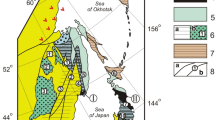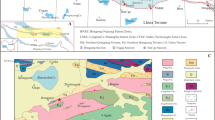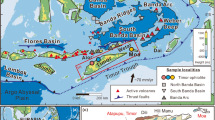Abstract
THE exposed portions of the Canary Islands largely comprise Cainozoic volcanic rocks erupted sub-aerially in successions essentially specific to each island, though with somewhat complex interrelationships1. On three islands, Fuerteventura, La Palma, and Gomera these rocks rest unconformably on older formations which are similar enough to suggest that a common basement may exist. The largest area of the basement complex rocks is the Betancuria Massif2–4, Fuerteventura. Gastesi4 has suggested that similarities exist between the Betancuria Massif and other ophiolite complexes (such as the Troodos Massif of Cyprus5,6) generally held to be representative of oceanic crust formed at certain constructive plate margins.
This is a preview of subscription content, access via your institution
Access options
Subscribe to this journal
Receive 51 print issues and online access
$199.00 per year
only $3.90 per issue
Buy this article
- Purchase on Springer Link
- Instant access to full article PDF
Prices may be subject to local taxes which are calculated during checkout
Similar content being viewed by others
References
Anguita, F., and Hernan, F., Earth planet. Sci. Lett. (in the press).
Fuster, J. M., Cendrero, A., Gastesi, P., Ibarrola, E., and Lopez Ruiz, J., Geology and Volcanology of the Canary Islands, Fuerteventura (Instituto Lucas Mallada, Madrid, 1968).
Gastesi, P., Estudies geol. Inst. Invest. geol. Lucas Mallada, 25, 1 (1969).
Gastesi, P., Nature phys. Sci., 246, 102 (1973).
Gass, I. G., Nature, 220, 39 (1968).
Moores, E. M., and Vine, F. J., Phil. Trans. R. Soc., A 268, 443 (1971).
Rothe, P., Geol. Rdsch., 55, 314 (1968).
Fuster, J. M., and Aguilar, M., Estudios geol. Inst. Invest. geol. Lucas Mallada, 21, 181 (1965).
Melson, W. G., and Van Andel, Tj. H., Mar. Geol., 4, 165 (1966).
Penrose Field Conference ‘Ophiolites’, Geotimes, 17, 24 (1972).
Roeser, H. A., Hinz, K., and Plaumann, J., Inst. geol. Sci. Rep. 70/16, 4, 27 (1970).
Beck, R. H., and Lehner, P., Bull. Am. Ass. Petrol. Geol., 58, 376 (1974).
Rothe, P., and Schmincke, H. U., Nature, 218, 1152 (1968).
Dietz, R. S., and Sproll, W. P., Nature, 266, 1043 (1970).
Hernandez Pacheco, A., and Ibarrola, E., Lithos, 6, 389 (1973).
Fuster, J. M., Estudios geol. Inst. Invest. geol. Lucas Mallada (in the press).
Abdel-Monem, A., Watkins, N. D., and Gast, P. W., Am. J. Sci., 271, 490 (1971).
Author information
Authors and Affiliations
Rights and permissions
About this article
Cite this article
STILLMAN, C., BENNELL-BAKER, M., SMEWING, J. et al. Basal complex of Fuerteventura (Canary Islands) is an oceanic intrusive complex with rift-system affinities. Nature 257, 469–471 (1975). https://doi.org/10.1038/257469a0
Received:
Accepted:
Issue Date:
DOI: https://doi.org/10.1038/257469a0
This article is cited by
-
Timing of rapid cooling and erosional decay of two volcanic islands of the Canary Archipelago: implications from low-temperature thermochronology
International Journal of Earth Sciences (2023)
-
Low-pressure, water-assisted anatexis of basic dykes in a contact metamorphic aureole, Fuerteventura (Canary Islands): oxygen isotope evidence for a meteoric fluid origin
Contributions to Mineralogy and Petrology (2007)
-
Using a genetic algorithm for 3-D inversion of gravity data in Fuerteventura (Canary Islands)
International Journal of Earth Sciences (2005)
-
N-MORB crust beneath Fuerteventura in the easternmost part of the Canary Islands: evidence from gabbroic xenoliths
Contributions to Mineralogy and Petrology (2005)
-
Age and composition of the Amanay Seamount, Canary Islands
Marine Geophysical Researches (2003)
Comments
By submitting a comment you agree to abide by our Terms and Community Guidelines. If you find something abusive or that does not comply with our terms or guidelines please flag it as inappropriate.



